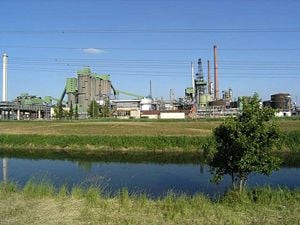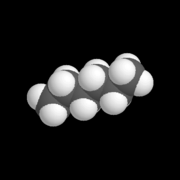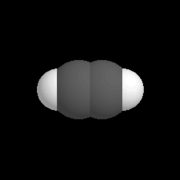Hydrocarbon
In chemical terms, a hydrocarbon is any compound that is constituted of just the elements carbon (C) and hydrogen (H). Each hydrocarbon molecule consists of a carbon backbone, or "carbon skeleton," with hydrogen atoms attached to that backbone.
Hydrocarbons are among the Earth's most important natural resources. They are currently the main source of the world’s electric energy and heat sources (such as home heating) because of the energy produced when burnt. In addition, many of them are useful as building blocks for the chemical synthesis of other organic compounds.
Simple hydrocarbons
The simplest hydrocarbon is methane, the main constituent of natural gas. Its chemical formula, CH4, indicates that each molecule of methane consists of four hydrogen atoms attached to one carbon atom. Ethane, with the formula C2H6, is a hydrocarbon (more specifically, an alkane) in which each molecule has two carbon atoms held together with a single covalent bond, and three hydrogen atoms are bound to each carbon atom. Each molecule of propane (C3H8) has three carbon atoms, and each molecule of butane (C4H10) has four carbons.
 A model of an arene called Benzene |
Three types of hydrocarbons
There are essentially three types of hydrocarbons:
- aromatic hydrocarbons, which have at least one aromatic ring
- saturated hydrocarbons, also known as alkanes, which don't have any double, triple or aromatic bonds
- unsaturated hydrocarbons, which have one or more double or triple bonds between carbon atoms, are divided into:
The number of hydrogen atoms
The number of hydrogen atoms in hydrocarbons can be determined, if the number of carbon atoms is known, by using these following equations:
- Alkanes: CnH2n+2
- Alkenes: CnH2n (assuming only one double bond)
- Alkynes: CnH2n-2 (assuming only one triple bond)
- Cyclic hydrocarbons: CnH2n
Each of these hydrocarbons must follow the 4-hydrogen rule which states that all carbon atoms must have the maximum number of hydrogen atoms that it can hold (the limit is four). A carbon atom has a bonding capacity of 4 and therfore must make 4 bonds, whether it be with hydrogen or an ajoining carbon atom. Note, an extra bond removes 2 hydrogen atoms and only saturated hydrocarbons can attain the full four. This is because of the unique positions of the carbon's four electrons.
Molecular graph
Usually carbon backbone is represented as molecular graph in which only carbon atoms are represented as vertices and bonds as edges. Molecular graphs contain the structure of the hydrocarbon in which missing hydrogen atoms can be added in a unique way. Hydrocarbons are extensively studied in mathematical chemistry.
Petroleum
Liquid geologically-extracted hydrocarbons are referred to as petroleum (literally "rock oil") or mineral oil, while gaseous geologic hydrocarbons are referred to as natural gas. All are significant sources of fuel and raw materials as a feedstock for the production of organic chemicals and are commonly found in the Earth´s subsurface using the tools of petroleum geology.
The extraction of liquid hydrocarbon fuel from a number of sedimentary basins has been integral to modern energy development. Hydrocarbons are mined from tar sands, oil shale and potentially extracted from sedimentary methane hydrates. These reserves require distillation and upgrading to produce synthetic crude and petroleum.
Oil reserves in sedimentary rocks are the principal source of hydrocarbons for the energy, transport and petrochemical industries. Hydrocarbons are of prime economic importance because they encompass the constituents of the major fossil fuels (coal, petroleum, natural gas, etc.) and biofuels, as well as plastics, paraffin, waxes, solvents and oils. In urban pollution, these components—along with NOx and sunlight—all contribute to the formation of tropospheric ozone.
The concentration of hydrocarbon vapours can be harmful if inhaled.
Burning hydrocarbons
Most hydrocarbons are combustible. When burnt, they produce carbon dioxide, water, and a lot of heat. We rely on this energy to heat our homes (and other buildings) and to generate electricity. When heating a home, for example, oil or natural gas is burnt and the energy released is used to heat water or air. The hot water or air is then circulated around the building. A similar principle is used to create electric energy in power plants. Hydrocarbons (usually coal) are burnt and the energy released in this way is used to turn water into steam, which is used to turn a turbine that generates energy.
In an ideal reaction, the waste would be only water and carbon dioxide but because the coal is not pure or clean there are often many toxic byproducts such as mercury and arsenic. Also, incomplete combustion causes the production of carbon monoxide which is toxic because it will bind with hemoglobin more readily than oxygen, so if it is breathed in, oxygen can not be absorbed, causing suffocation. Incomplete combustion also has a byproduct of carbon in the form of soot.
Coal reserves will last for decades and possibly beyond 2100. Mostly in response to climate concerns, clean coal technology is currently under development. For example, the UK and China have signed an agreement to develop such technology with carbon dioxide emissions capture and storage in both China and the EU by 2020. Similar research is being conducted in the U.S. and other countries. By some, hydrocarbons in the atmosphere are considered to be dangerous air pollutants.
External links
- The Methane Molecule
- Dismissal of the Claims of a Biological Connection for Natural Petroleum.
- Poten & Partners: Glossary of Hydrocarbon Terms
See also
- Abiogenic petroleum origin
- Energy storage
- Fractional distillation
- Functional group
- Alkanes
Credits
New World Encyclopedia writers and editors rewrote and completed the Wikipedia article in accordance with New World Encyclopedia standards. This article abides by terms of the Creative Commons CC-by-sa 3.0 License (CC-by-sa), which may be used and disseminated with proper attribution. Credit is due under the terms of this license that can reference both the New World Encyclopedia contributors and the selfless volunteer contributors of the Wikimedia Foundation. To cite this article click here for a list of acceptable citing formats.The history of earlier contributions by wikipedians is accessible to researchers here:
The history of this article since it was imported to New World Encyclopedia:
Note: Some restrictions may apply to use of individual images which are separately licensed.


